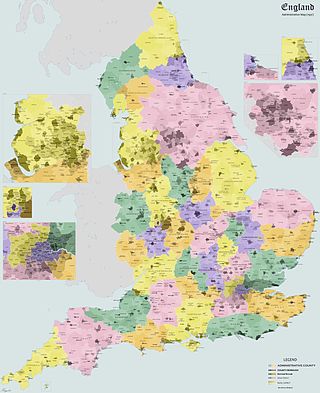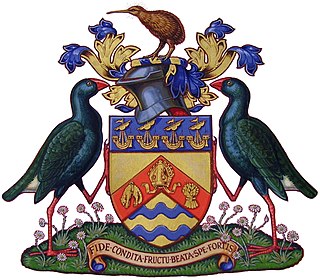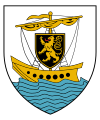
The Collegiate Church of St. Nicholas is a medieval church building in Galway, Ireland. It is a collegiate church and the parish church of St. Nicholas Church of Ireland parish, which covers Galway City. It was founded in 1320 and dedicated to Saint Nicholas of Myra, the patron saint of seafarers, in recognition of Galway's status as a port. The monumental work of Irish genealogy, the Leabhar na nGenealach was produced here in 1650 by Duḃaltaċ MacḞirḃisiġ.

A municipal borough was a type of local government district which existed in England and Wales between 1835 and 1974, in Northern Ireland from 1840 to 1973 and in the Republic of Ireland from 1840 to 2002. Broadly similar structures existed in Scotland from 1833 to 1975 with the reform of royal burghs and creation of police burghs.

Galway City Council is the local authority in the city of Galway, Ireland. As a city council, it is governed by the Local Government Act 2001. The council is responsible for housing and community, roads and transportation, urban planning and development, amenity and culture, and environment. The council has 18 elected members. Elections are held every five years and are by single transferable vote. The head of the council has the title of mayor. The city administration is headed by a Chief Executive, Patricia Philbin. The council meets at City Hall, College Road, Galway.

The Mayor of Christchurch is the head of the municipal government of Christchurch, New Zealand, and presides over the Christchurch City Council. The mayor is directly elected using a First Past the Post electoral system. The current mayor, Phil Mauger, was elected in the 2022 mayoral election. The current deputy mayor is Pauline Cotter.
William Óge Martyn was the 101st Mayor of Galway.

The functions of local government in the Republic of Ireland are mostly exercised by thirty-one local authorities, termed County, City, or City and County Councils. The principal decision-making body in each of the thirty-one local authorities is composed of the members of the council, elected by universal franchise in local elections every five years from multi-seat local electoral areas using the single transferable vote. Many of the authorities' statutory functions are, however, the responsibility of ministerially appointed career officials termed Chief executives. The competencies of the city and county councils include planning, transport infrastructure, sanitary services, public safety and the provision of public libraries. Each local authority sends representatives to one of three Regional Assemblies.
A municipal corporation is the legal term for a local governing body, including cities, counties, towns, townships, charter townships, villages, and boroughs. The term can also be used to describe municipally owned corporations.

The Local Government Act 2001 was enacted by the Oireachtas on 21 July 2001 to reform local government in the Republic of Ireland. Most of the provisions of the Act came into operation on 1 January 2002. The act was a restatement and amendment of previous legislation, which was centred on the Local Government (Ireland) Act 1898. The 2001 act remains in force, although significantly amended by the Local Government Reform Act 2014.
A municipal council is the legislative body of a municipality or local government area. Depending on the location and classification of the municipality it may be known as a city council, town council, town board, community council, rural council, village council, or board of aldermen.
The Battle of Knockdoe took place on 19 August 1504.
at Knockdoe, in the Parish of Lackagh, County Galway, between two Anglo-Irish lords—Gerald FitzGerald, Earl of Kildare, the Lord Deputy of Ireland, and Ulick Fionn Burke, 6th Clanricarde (d.1509)—along with their respective Irish allies. The cause was a dispute between Maelsechlainn mac Tadhg Ó Cellaigh (O'Kelly), King of Ui Maine – Mod. Irish Uí Mháine) and Clanricarde.

The Local Government Act 1972 was an Act of the Parliament of Northern Ireland that constituted district councils to administer the twenty-six local government districts created by the Local Government (Boundaries) Act 1971, and abolished the existing local authorities in Northern Ireland.
Dominick Lynch was mayor of Galway, Ireland.
Walter Lynch (Mayor), Mayor of Galway, fl. 1641-1642.
Edmond Deane was the 18th Mayor of Galway (1502–1504).
Bristol City Council, formerly known as The Bristol Corporation, is the local government authority governing the city of Bristol, England. Following the Norman conquest of England in 1066, successive royal charters granted increasing rights of local governance to Bristol. County status was attained in 1373 and city status in the early sixteenth century. Bristol Corporation was established in the nineteenth century and the office of Lord Mayor was created in 1888. Following a brief period as part of the county of Avon in the late twentieth century, Bristol regained its status as a city and county in 1996.
In Ireland, the term city has somewhat differing meanings in Northern Ireland and the Republic of Ireland.
Máire Lynch, Countess of Clanricarde, fl. 1547.
Events from the year 1484 in Ireland.
Liverpool Town Council existed from 1835 to 1880.

The Lord Mayor of Cork is the honorific title of the Chairperson of Cork City Council which is the local government body for the city of Cork in Ireland. The office holder is elected annually by the members of the Council. The incumbent is Kieran McCarthy.









